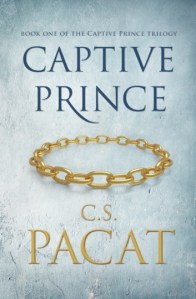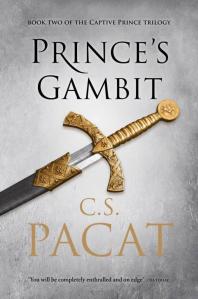 Captive Prince by C.S. Pacat leapt to the top of my to-be-read pile the instant I heard about it last weekend, because it ticks three of my current preferred boxes: It’s a secondary world fantasy, written by an Australian woman (meaning I can review it for the Australian Women Writers challenge), and it’s centred on a male/male relationship (yep, I’m still on that train). I’ve rarely one-clicked so fast.
Captive Prince by C.S. Pacat leapt to the top of my to-be-read pile the instant I heard about it last weekend, because it ticks three of my current preferred boxes: It’s a secondary world fantasy, written by an Australian woman (meaning I can review it for the Australian Women Writers challenge), and it’s centred on a male/male relationship (yep, I’m still on that train). I’ve rarely one-clicked so fast.
The story behind it is pretty awesome too. The author originally published the book/s in serial format on her blog, garnered a worldwide following, and was then picked up by Penguin for a fantasy trilogy. The first two books — Captive Prince and Prince’s Gambit — were published in March 2014, while the third — Kings Rising — comes out in February 2016. (Waiting, waiting, waiting…)
I’m talking about both Captive Prince and Prince’s Gambit in this review, because in my opinion it’s one continuous story. It seems pretty obvious the publishers have taken one 600p novel and split it at a fairly major turning point — meaning this is a two-book commitment. Do not finish the first book without having the second no more than a click away. You have been warned.
Captive Prince is based on a fairly familiar premise: Prince Damen is betrayed by his half-brother and gifted as a pleasure slave to a rival nation’s crown prince, Laurent. Damen is a noble-hearted and charismatic young man, a legendary warrior at just 25, accustomed to having his own bed-slaves. (He’s probably a bit too perfect, really.) The story is told entirely from his point of view, and focuses initially on him trying to deal with his situation, conceal his true identity, and escape back to his homeland.
Thwarting him in this is Laurent, the 20-year old crown prince, whose throne is occupied by his uncle as Regent. Seen through Damen’s eyes, Laurent is beautiful, coldly controlled, wildly intelligent. His hatred of Damen’s people is palpable, and he treats Damen maliciously. But very gradually the two start to develop mutual respect (of sorts) and trust (of sorts) as it becomes clear they need to work together to survive the machiavellian plotting in the Regent’s court.
Laurent is a fascinatingly complex character, made all the more mysterious by the fact we don’t get inside his head. By the end of the second book, Damen understands him better than just about anyone, but Laurent’s cold control, vicious anger, and his ability to scheme and plan ahead still repeatedly astonishes Damen.
Not that Damen is an open book himself. Even though it’s told from a tight 3rd person point of view, Damen still manages to keep his cards close to his chest — in fact, that aspect of the writing is wonderful. Pacat keeps the internal angst to a minimum, but still the reader has a pretty clear idea of Damen’s true emotions and motivations. And also when he’s lying to himself.
This is not a “Stockholm Syndrome” story. It really isn’t. A huge part of the novels is the relationship between Damen and Laurent, but I wouldn’t call it a ‘romance’. These are two men on opposite sides of a very real conflict and that takes precedence for much of the time. By the end of the first book they haven’t even developed a friendship, and there is little intimacy between them until late in the second book.
But, yes, they ultimately do fall for each other. Having said that, their relationship is very far from resolved by the end of Prince’s Gambit. (Waiting, waiting, waiting…)
The secondary world of the Captive Prince books is a fairly familiar one. There are kings and princes and armies and castles and mountains and fields and brothels and courtiers and pleasure slaves… One aspect that is a little different, however, is the attitude to same-sex pairings. In the cultures of both men it’s widely accepted and Damen thinks nothing of swinging both ways (although claims to prefer women).
In Laurent’s culture, on the other hand, same-sex coupling is more common than hetero relationships — among the nobility at least — the reason being that children born out of wedlock are taboo. I actually couldn’t figure out at what point it became socially acceptable for men and women to sleep together.
I should also mention that one or two of the “performance” slave sex scenes were non-consensual (or had the appearance of it least) and this could be triggery for some people. On the whole, though, there is not really a lot of sex in these books, despite the society’s fixation on it.
Even though it’s a bit of a cookie-cutter world, the story is still intriguing and the characters fabulously drawn. Captive Prince (first book) is set almost solely in the court of Laurent and the Regent. It’s very much setting the scene for various relationships — including between Laurent and his uncle — and involves a fair bit of politicking among the court. But I have to say it doesn’t hold on its own as a novel. It was easy to read and fairly fast-paced, but absolutely nothing resolves.
Prince’s Gambit picks up exactly where Captive Prince left off — and here the story opens up and out and gets so much better. Not only is the story no longer confined to the palace, as Laurent heads off with a small force to man the border, but there is a greater array of characters and simply more going on. Laurent and Damen’s extremely complex relationship is finally allowed to develop as well (and I don’t necessarily mean in a romantic way), and it’s beautifully done.
The overarching story in Prince’s Gambit has Damen helping Laurent thwart a sinister plot and attempt to prevent war between their two nations, after which Damen intends to simply leave and return home. Both Laurent’s and Damen’s characters unfold in interesting ways, and there are plenty of plot twists and turns leading up to some dramatic military action — and the scene where Damen and Laurent are finally intimate is heart-stopping.
But each still has kept secrets from the other and things are about to unravel badly at the close of Prince’s Gambit, which ends on something of a cliffhanger. (Waiting, waiting, waiting…)
I don’t actually have much to quibble about with these books. At the moment, a lot of Laurent’s actions and hangups are still unexplained, but I hope the third book will provide insights into these. I also think it’s difficult to consider Captive Prince in isolation; it lays critical foundations and is a great read, but really does need the second part to be satisfying.
On the whole, these books as a pair get the big thumbs up from me. I felt emotionally invested in both characters and am desperate to read Kings Rising. There is still a huge amount of story to unfold as both princes reclaim their birthrights — and of course figure out their relationship with each other. Which isn’t going to be easy, given their respective identities and responsibilities. This may well turn out to be one of the great fantasy love stories…
I really like the combination of ‘grand fantasy epic’, with nations and kings and political machinations and battles, and the intensely personal. I will almost certainly read them again before the third is out next year, because the character relationships are so finely nuanced. I love that. My recommendation would be to buy them now (so you don’t forget), but wait until the third is out before you read them!
Side note: Last year I read the Song of the Fallen (Counterpoint and Crescendo — by Rachel Haimowitz), which is based on a very similar premise — although unfolds very differently. I enjoyed these a lot as well and I talked a little about them in my ‘What I read in November‘ post from last year.



Hmm…
Um,
Hmm…
😉
LikeLike
I’m not entirely sure what that means… have I convinced you?
LikeLiked by 1 person
I don’t know. I’ve got the first book, but I’m thinking of taking your advice and saving it till #3 is done, then reading them in succession. You make ’em sound awfully intriguing…
LikeLiked by 1 person
yeah, I would do that. Read them all at once. I’ll remind you. 🙂
LikeLiked by 1 person